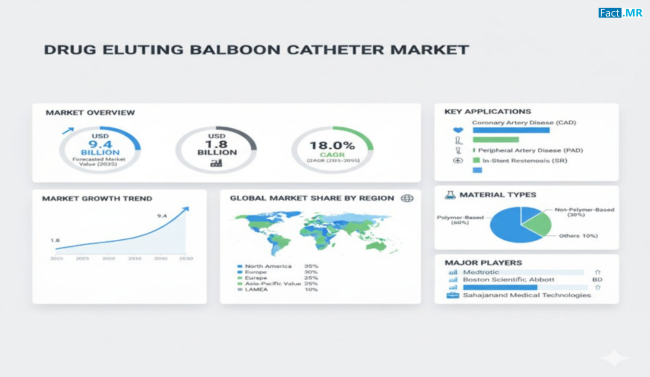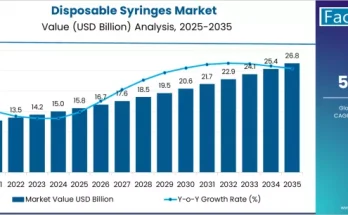The drug eluting balloon (DEB) catheter market is witnessing rapid evolution as cardiovascular diseases continue to pose significant health challenges globally. DEB catheters, designed to deliver therapeutic agents directly to arterial walls during angioplasty procedures, offer an effective solution for managing restenosis and enhancing vascular healing. With increasing adoption in interventional cardiology, technological advancements, and rising awareness of minimally invasive therapies, the DEB catheter market is poised for substantial growth in the coming decade.
Market Overview:
Drug eluting balloon catheters are specialized medical devices that combine mechanical dilation of blood vessels with localized drug delivery. Unlike traditional stents, DEB catheters allow targeted drug release without leaving permanent implants, reducing the risk of chronic complications.
The market is driven by the growing preference for minimally invasive procedures, advancements in catheter design, and the need for efficient management of coronary and peripheral arterial diseases. Innovations in coating technologies, drug formulations, and delivery mechanisms are enhancing the efficacy of DEB catheters, enabling uniform drug distribution and improved arterial healing.
Additionally, hospitals and cardiac care centers are increasingly adopting these devices due to their clinical advantages, such as reduced procedure times, fewer follow-up interventions, and enhanced patient recovery. The combination of precision engineering and pharmacological innovation is establishing DEB catheters as a vital tool in modern cardiovascular care.
Regional Insights:
North America leads the drug eluting balloon catheter market due to advanced healthcare infrastructure, widespread adoption of interventional cardiology procedures, and strong clinical research presence. The region’s focus on improving patient outcomes and reducing cardiovascular disease burden is driving the uptake of DEB technology.
Europe is another key market, supported by a mature healthcare system, early adoption of minimally invasive procedures, and stringent regulatory frameworks ensuring the quality and safety of medical devices. Continuous clinical studies and reimbursement policies promoting advanced catheter-based therapies are further bolstering market growth.
Asia-Pacific is emerging as a rapidly growing region, fueled by rising prevalence of cardiovascular diseases, improving healthcare infrastructure, and increasing patient awareness. Countries such as China, Japan, and India are witnessing significant investments in cardiac care facilities, which is driving the adoption of DEB catheters.
Latin America and the Middle East & Africa are gradually expanding their use of DEB technology, aided by increasing cardiovascular healthcare initiatives, improved access to advanced medical devices, and growing clinical expertise in interventional cardiology.
Innovations and Regulatory Trends:
Innovation in the DEB catheter market focuses on improving drug delivery efficiency, safety, and procedural outcomes. Advanced coating technologies are being developed to enhance drug absorption and uniformity while minimizing systemic exposure. Biodegradable polymers and new anti-proliferative drug formulations are also emerging to improve long-term vessel patency.
Integration of imaging technologies and guidewire systems with DEB catheters is enabling more precise placement and better procedural accuracy. These technological enhancements not only optimize clinical outcomes but also expand the range of treatable vascular conditions.
Regulatory trends are shaping product development and market adoption. Agencies across major healthcare markets emphasize stringent clinical validation, safety testing, and post-market surveillance to ensure patient safety and device effectiveness. Compliance with these regulatory standards encourages the development of high-quality, reliable DEB catheters and builds trust among healthcare providers.
Key Trends & Forecast:
The DEB catheter market is evolving through several notable trends:
- Shift Toward Minimally Invasive Procedures: Growing preference for non-stent interventions supports DEB adoption in both coronary and peripheral applications.
- Technological Advancements in Drug Delivery: Innovations in drug formulations, polymer coatings, and balloon design improve therapeutic efficiency and vessel healing.
- Integration with Imaging and Navigation Systems: Enhanced catheter visibility and accurate placement are increasing procedural precision and safety.
- Rising Clinical Research and Trials: Ongoing studies evaluating DEB efficacy in various vascular conditions are expanding the evidence base and driving adoption.
- Focus on Peripheral Artery Disease (PAD): Increasing prevalence of PAD is creating new opportunities for DEB catheters in peripheral interventions.
These trends emphasize the market’s focus on improving patient outcomes, procedural efficiency, and the overall safety profile of cardiovascular interventions.
Applications & End-Use Outlook:
Drug eluting balloon catheters find applications across multiple cardiovascular procedures:
- Coronary Artery Disease (CAD): DEBs are widely used to treat restenosis and complex coronary lesions, providing targeted drug therapy without permanent stent implantation.
- Peripheral Artery Disease (PAD): DEBs are increasingly utilized in peripheral vascular interventions, including femoropopliteal and infrapopliteal arteries, to reduce restenosis and improve limb salvage rates.
- Renal and Other Vascular Applications: Emerging applications include treatment of renal arteries, dialysis access sites, and other small vessels where conventional stents may pose complications.
Hospitals, cardiac centers, and interventional cardiology clinics are the primary end-users of DEB catheters. The growing emphasis on patient-centered care, minimally invasive procedures, and faster recovery is driving wider adoption across these healthcare settings.
Competitive Landscape:
The drug eluting balloon catheter market is highly competitive, with manufacturers focusing on innovation, clinical validation, and strategic partnerships. Companies are investing in research and development to improve drug delivery performance, enhance balloon durability, and expand product portfolios.
Collaborations with hospitals, research organizations, and medical institutions are fostering clinical trials, enabling faster product adoption and market penetration. Customization, regulatory compliance, and strong post-market support are key differentiators among leading players.
Sustainability initiatives, including the development of biodegradable and low-polymer devices, are further enhancing the competitive landscape while meeting evolving clinical and regulatory expectations.
Conclusion:
The drug eluting balloon catheter market is a crucial segment of modern cardiovascular healthcare, offering innovative solutions for managing coronary and peripheral arterial diseases. With ongoing technological advancements, integration of imaging systems, and a growing focus on minimally invasive procedures, DEB catheters are set to play a pivotal role in improving patient outcomes and clinical efficiency.
As healthcare providers continue to adopt advanced devices and techniques, the market is expected to witness robust growth, driven by innovation, clinical validation, and a commitment to safer, more effective cardiovascular interventions.
Browse Full Report – https://www.factmr.com/report/146/drug-eluting-balloon-catheter-market



